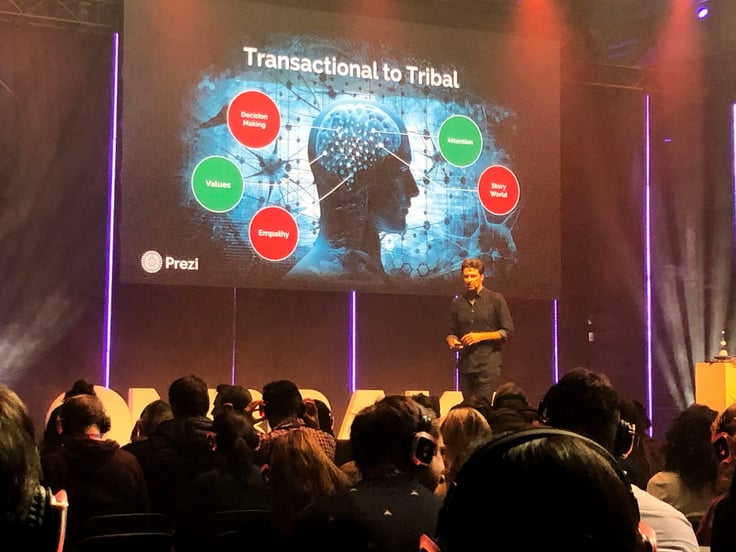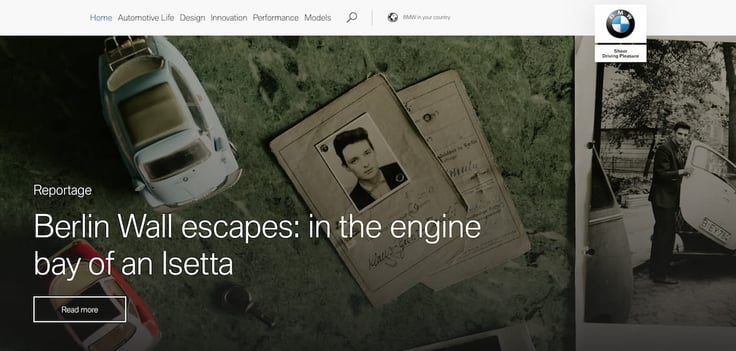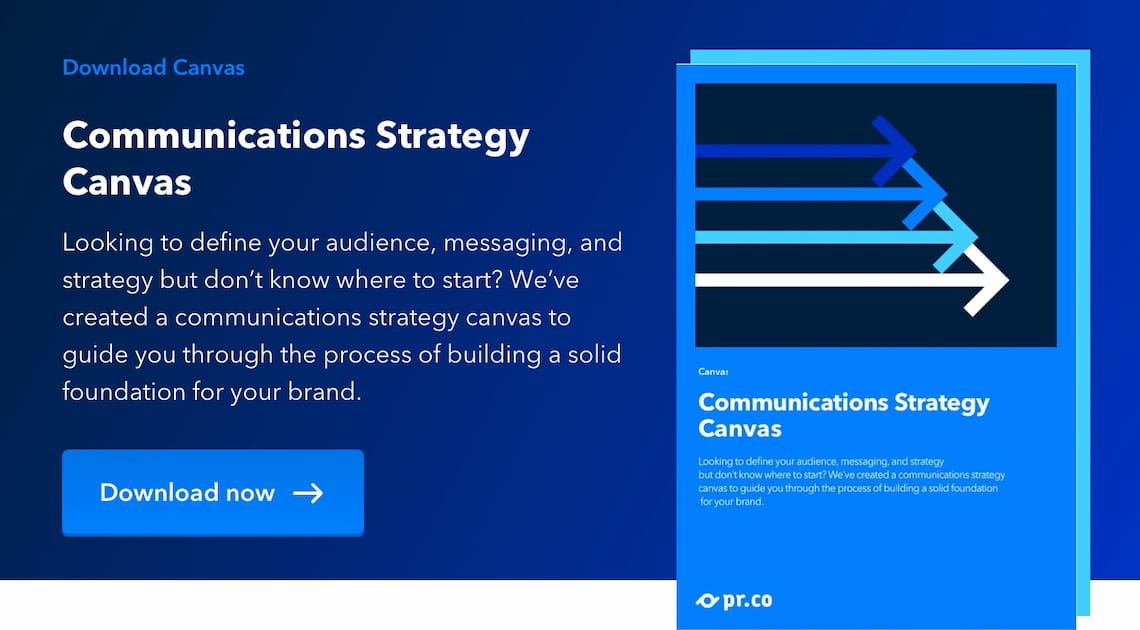When Spencer Waldron started working at Prezi, he was told the David and Goliath story of the small presentation software going up against the likes of Microsoft and Google. Now, with 100 million people using the software every day, they have shown that there is always space in the human heart for a good story. Here he breaks down the anatomy of a successful one.
.jpg?width=736&name=339208-spencer%20waldron%20profile%20pic-eb2b11-original-1574850016%20(1).jpg)
You must have seen countless stories at Prezi: what are the common features of stories that resonate?
If you tell a story, you do it because you want somebody to take action or make a decision. When you look at how we make a decision the process can be split into two parts: first we need to emotionally connect to the story and second, we need to rationalize it in our heads.
Stories that are powerful and the ones that get somebody to connect to something through the specific.
For example, the BBC wanted to tell the story of what’s going on in Syria, which is such a hard thing to do. So they started with the story of one person that symbolized what was going on. This technique is powerful because it transports you to a place you would not normally go.
Emotional connection using the specific is the key to conveying messages properly.
.jpg?width=736&name=338542-3c6f043d20f29b02f593465d8e0782d1-1c5997-original-1574262566%20(1).jpg)
Many brands are using emotion as a core element of their storytelling strategy. But sometimes you switch on the TV you get the impression that every advert is trying to make you cry.
Yes, sadvertising.
Will there come a point where audiences feel emotional fatigue- because we as communicators overdo it- and switch off?
It's a classic phenomenon. If people see something that works, lots of people will try and replicate it. But you know what? The most powerful thing that you can give somebody to move forward and take action is hope. There are a lot of ways that you can tell a story that's emotional. And they are not wrong or sad, but full of hope.
You see stories that are emotionally sad, which makes you reactive; you cry when you see somebody has died for example. But if you see a sad scene in a movie or advert you usually connect to it. There is a certain power in that. Nevertheless, if you want positive action from your audience, you need to work out how to turn your story into something that's hopeful in the end.
If you think about how we act when we're hopeful: we ask questions, we explore, we discover, we want to move forward. Hope is the thing that drives us as humans.
It's a very subtle change in how we communicate, but it's how you connect to people. Let them know you see the mission they’re on, you know values they have, you understand their motivations. Then show how you can help them.
As much as we have this amazing modern world around us, with tech that helps with everything you can imagine, our biology is the same as it has been for tens of thousands of years. We have the amygdala in the back of our head which is always wanting to keep us safe. The amygdala drives so many of our decisions because our brains were built for risk avoidance. It's why, when we suddenly think about doing something new, we go “Yeah, but….”. That's our amygdala saying “Stay in the comfort zone, don’t take risks. My job is to keep you safe”.
That's where brands and organizations should give encouragement. People think that courage comes from inside us; that it’s this magical thing that people have. But it doesn’t, courage comes from the outside. It comes from all the people that support, help, and mentor you. From moments you're given encouragement or feedback.
Nobody wakes up one morning and decides that they’re going to go and do a big audacious thing. We take baby steps. Because, again, our amygdala is only letting us take baby steps. But if you hear a story that affects you on an unconscious emotional level you think “I want to go and do that.”
.jpg?width=736&name=329638-robina-weermeijer-igwG8aIaypo-unsplash-0ec260-original-1568107950%20(1).jpg)
Logic is also an important part of decision-making. It’s what you and I are using now as we’re having this conversation, it’s how we rationalize. We want to know: “Is this a good thing? What evidence do I have? Can I trust this thing or this person?”
As a company, the two questions you need to ask in your communications are:
1) How do I get someone to connect to us emotionally?
2) How do I get people to trust that we can do the things that we say we're going to do?
If you look at Edelman’s trust barometer, trust of organizations is at an all-time low. So trust should be very high on people's agenda.
Do you think trust newly becoming a key goal of marketing strategy is having an impact on business?
I suspect not. Profit is still the main driving force of business. And that needs to change a bit. We're going through this massive transformation where companies are no longer able to hide behind profit as the sole driver of business. I've seen businesses that have a central mission to employ more people because they want to support the region, city, or neighborhood that they live in. And they're successful businesses, but their main goal is not profit, it’s employment as a means to grow the neighborhood.
Trust is something that's built over time. You can't say, ‘okay, we're going to build trust in 2020’. It's not going to happen; you have to build a reputation. It’s a marathon, not a sprint, and marathons take resources and dedication.
People now trust their friends, family, and work colleagues above everybody else. It’s an interesting debate to have: does business has the possibility to be a voice of trust. And if so what does that even look like?

How does technology enhance storytelling?
Technology is changing how we interact with stories. Most stories we come across are now online, through social media, or on streaming services. But if we separate business stories from general stories, they are mostly told from social media platforms. Even if you work really hard and craft an amazing story if you tell that story in the same way on every platform and won't work. If I'm on YouTube, then I'll give you 20 minutes of my time, because I’m on that platform I'm to learn or to be entertained. A blend of creativity and platform sensitivity can help us reach people.
I personally am super excited about augmented reality. I think it can completely change immersive storytelling. You can go to a museum in Amsterdam for example, to a 500-year-old house. And instead of reading about what it was like in that house, you can hold up your phone or your tablet and use AR to see what life was like 500 years ago. With this technology the possibilities for storytelling are endless. We already have the opportunity to use this technology in our communication. Most of our storytelling these days happens on social media and mostly via video. So here at Prezi we recently launched a new tool to help people place themselves and their graphics on the screen in real-time.
You said a brand is a promise. What did you mean by that?
We've had, six or seven decades of consumer marketing, where products were the hero of the story. Brands would say “Unfortunately, your life is not very good, but luckily I'm here with my products. I can make your life much better. All you need to do is buy me.” But that simply isn’t working anymore.
Nowadays you should look at your customer base and say, “Okay- here's my customer. And here's this big, audacious goal that she wants to achieve, whether it’s a new job, or marathon, or becoming a CEO.”
If you're a recruitment company and your mission is to help her become CEO; your job is to give her the courage, training, and tools she needs to start on that journey, not to hawk your product. It's a very subtle change in how we communicate, but it's how you connect to people. Let them know you see the mission they’re on, you know values they have, you understand their motivations. Then show how you can help them.
My job is to create that dialogue when you’re there for someone for the long haul. Which challenges the whole notion that after you get somebody to buy your product the relationship ends. You want to have a longer relationship with different types of touchpoints and rewards as time goes on. There are some really good examples of this, but I think it's still a vastly under-tapped way of reaching people. Customer success can have a huge role in this relationship.
You’ve talked about the transactional nature of corporate relationships. How do you explain to business stakeholders how important emotions and connection are?
People who are emotionally connected to you as a founder or a company tend to be more loyal, easier to convert, and spend more money. MBLM does a great annual Brand Intimacy Study which ranks organizations based on their emotional connection to their customers.
Last year BMW was number one in the US. If you look at how we make a decision, there are three different things going on. There's risk avoidance, there's a reward (what's in it for me?) and there's novelty (is it different/new, does it spark my attention?) That’s where BMW does a really good job. In terms of novelty, they have all these amazing concept cars of the future. They have light-absorbing paint and all these cool things that make you say “wow, that's very different”, so you pay attention.
Historically the reward was about status. What does it say about me if I have this object? And how good is the driving experience? Is it different and unique, do I feel like it adds something to my life? Looking at what for me is the most important factor, risk avoidance, BMW does a great job in soothing those fears. You can build your car online on their website and when you get stuck, you can talk to a BMW genius. They make sure that you haven't got any risks in your mind and you've got exactly the car that suits you.
They have first-class customer support, servicing, maintenance, all those touchpoints. When a brand is purposeful with addressing the whole journey, the rewards of their efforts are clear.

What are common brand communication mistakes that you’ve observed?
One is the way you build customer personas. Empathy mapping is a lot more involved. You get such a different view of people. So instead of working out normal things like who people are, where they work, what they’ve bought, what they’ve done on your website, it’s better to start asking questions on how people feel about stuff.
What are tasks that they have to do like? what are the obstacles in their way? who do they trust? what values do they have?
It’s the difference between telling stories that you want to tell versus stories your customers actually need to hear. Very subtle difference, massive change. Because we all say we need to tell a story about X, Y and Z. But when you talk to your customers and do empathy mapping a different story will emerge: one that will still help you achieve your objectives but will create much deeper connections.
A good example is Google India’s advert ‘reunion’. It was the story of a daughter trying to reunite her grandfather and his best friend from childhood, who were separated during the partitioning of India and Pakistan. The whole story follows her reuniting these two after not seeing each other for many years. It’s a classic example of sadvertising, but it's very powerful.
I use it as an example because although this is a piece of storytelling that seems to feature every Google product known to man in the advert, the product doesn't get in the way because it's not the hero. The hero of the story is the daughter who is trying to reunite her grandfather and his friend. It’s not a story that you would have thought to get into and yet it was hugely successful, human stories make products take on a life of their own.
Spencer Waldron is the founder of Cenrox, a presentation skills training agency. He also worked as the Director of Marketing and Public Relations at Prezi, the dynamic presentation platform used by more than 100M people around the world. With over 15 years of experience in the industry, he dedicates his time to helping users be better presenters, public speakers and communicators in meetings and conferences . Spencer regularly hosts Storytelling & Presentation Skills workshops across Europe, focused on the power of business storytelling.. Connect on LinkedIn or send an email







